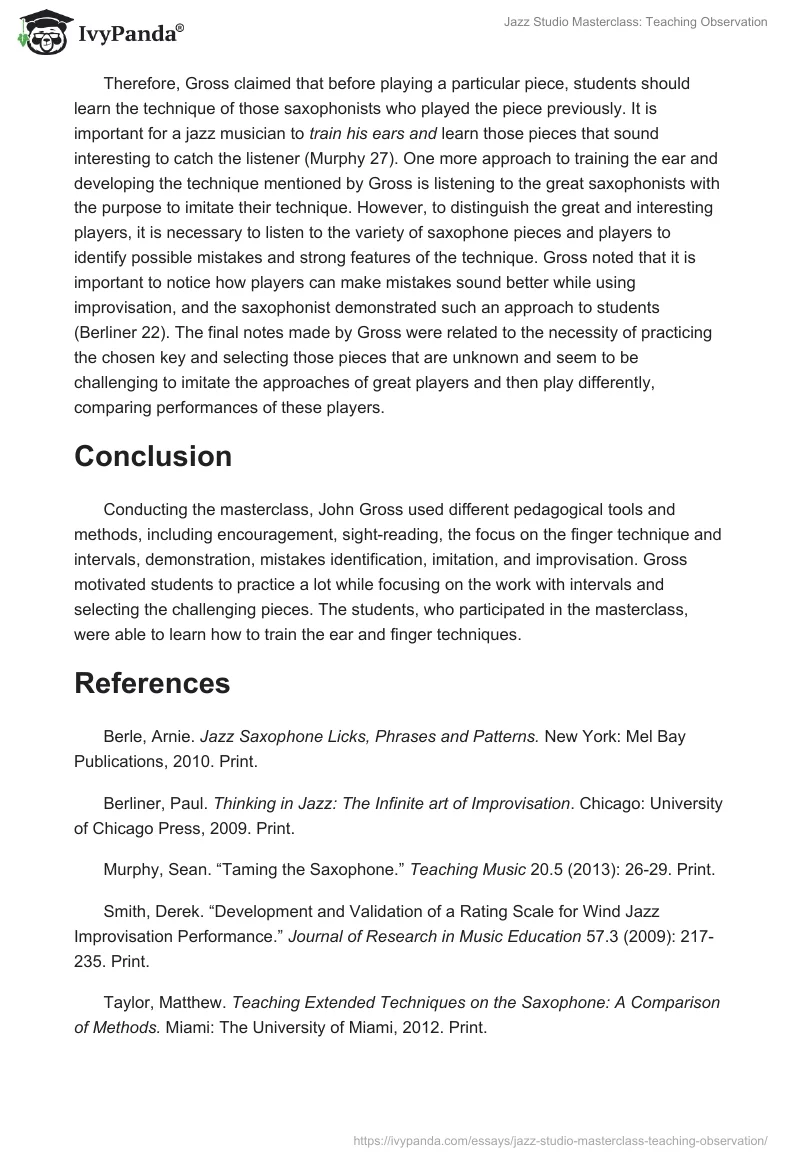Introduction
The masterclass with John Gross, a jazz saxophonist, lasted 90 minutes. Gross started from telling the story of his path in the field of jazz and focused on motivating students to challenge themselves to play the music that nobody wants to play. This practice aims to improve not only the technique but also the understanding of jazz music (Whitehead 54). After these introductory notes, Gross asked a student to challenge himself and focus on sight-reading to improve the understanding of the saxophone music character (Berle 12). Gross selected a specific piece to play, and when the student stopped playing, Gross asked him about his feelings and any questions. Referring to the student’s questions, Gross focused on the role of a melody in playing the saxophone when it is necessary to produce a specific jazz sound. Gross asked students to pay more attention to overtones while playing.
Main body
After answering the questions, Gross focused on the character of jazz music and its impact on playing the saxophone. Gross noted that saxophonists often find playing different scales as challenging tasks, but the problem is in the lack of the developed finger technique, and more finger exercises are necessary (Taylor 12). While exercising, it is also important to pay attention to minor scales and minor thirds. The other challenge is intervals, especially broken chromatic intervals. Gross explained how octaves and the fifths along with the non-tone and twelve-tone could influence the melodic pattern. Gross stated that when students pay attention to the intervallic practicing, they also become good at understanding the jazz music and combining scales and different intervals (Smith 218). Gross demonstrated how it is possible to combine the intervals to achieve a certain melodic pattern and noted that, in this case, the success depends on the finger technique and on the ability to ‘feel’ the music.
Therefore, Gross claimed that before playing a particular piece, students should learn the technique of those saxophonists who played the piece previously. It is important for a jazz musician to train his ears and learn those pieces that sound interesting to catch the listener (Murphy 27). One more approach to training the ear and developing the technique mentioned by Gross is listening to the great saxophonists with the purpose to imitate their technique. However, to distinguish the great and interesting players, it is necessary to listen to the variety of saxophone pieces and players to identify possible mistakes and strong features of the technique. Gross noted that it is important to notice how players can make mistakes sound better while using improvisation, and the saxophonist demonstrated such an approach to students (Berliner 22). The final notes made by Gross were related to the necessity of practicing the chosen key and selecting those pieces that are unknown and seem to be challenging to imitate the approaches of great players and then play differently, comparing performances of these players.
Conclusion
Conducting the masterclass, John Gross used different pedagogical tools and methods, including encouragement, sight-reading, the focus on the finger technique and intervals, demonstration, mistakes identification, imitation, and improvisation. Gross motivated students to practice a lot while focusing on the work with intervals and selecting the challenging pieces. The students, who participated in the masterclass, were able to learn how to train the ear and finger techniques.
References
Berle, Arnie. Jazz Saxophone Licks, Phrases and Patterns. New York: Mel Bay Publications, 2010. Print.
Berliner, Paul. Thinking in Jazz: The Infinite art of Improvisation. Chicago: University of Chicago Press, 2009. Print.
Murphy, Sean. “Taming the Saxophone.” Teaching Music 20.5 (2013): 26-29. Print.
Smith, Derek. “Development and Validation of a Rating Scale for Wind Jazz Improvisation Performance.” Journal of Research in Music Education 57.3 (2009): 217-235. Print.
Taylor, Matthew. Teaching Extended Techniques on the Saxophone: A Comparison of Methods. Miami: The University of Miami, 2012. Print.
Whitehead, Kevin. Why Jazz?: A Concise Guide. New York: Oxford University Press, 2010. Print.


